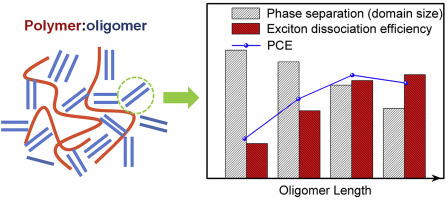Organic Electronics ( IF 2.7 ) Pub Date : 2018-04-03 , DOI: 10.1016/j.orgel.2018.04.003 Yingying Fu , Jianfei Qu , Yanhou Geng , Bei Wang , Yanchun Han , Zhiyuan Xie

|
Four fluorene-alt-di-2-thienyl-benzothiadiazole (FTBT) based oligomers with different number of repeated units are selected as electron acceptors in P3HT:oligomer solar cells. The effect of oligomer length on the phase separation behavior has been studied in detail. It is disclosed that the oligomer length strongly affects the film morphology and hence the exciton dissociation probability, charge transport as well as recombination characteristics. The short oligomer F1TBT1 is prone to aggregate and form large-scale phase separation which impedes exciton dissociation in the blend films. With increasing the acceptor length, large-scale aggregations are gradually suppressed due to the weakened migration ability of long FTBT oligomers in polymer matrix. Meanwhile, electron mobilities are enhanced with extending the oligomer length, which is favorable to suppress charge recombination in the blends. Finally, optimal photovoltaic performances with a PCE of 4.19% are achieved in P3HT:F3TBT3 based solar cell that compromises well between efficient exciton dissociation and balanced charge transport, which is almost three times higher than the F1TBT1 based device. This work highlights that tailoring the oligomer length can be used as an effective strategy to control phase separation and to enhance the photovoltaic performance in non-fullerene based polymer solar cells.
中文翻译:

洞察聚合物:低聚物基太阳能电池中分子长度与激子解离,电荷迁移和重组之间的相关性
在P3HT:低聚物太阳能电池中,选择了四个具有不同重复单元数的芴-alt-二-2-噻吩基-苯并噻二唑(FTBT)基低聚物作为电子受体。已详细研究了低聚物长度对相分离行为的影响。公开了低聚物的长度强烈影响膜的形态,并因此影响激子离解的可能性,电荷传输以及重组特性。短的低聚物F1TBT1易于聚集并形成大规模的相分离,从而阻碍了共混膜中的激子解离。随着受体长度的增加,由于长FTBT低聚物在聚合物基质中的迁移能力减弱,逐渐抑制了大规模聚集。同时,电子迁移率随着低聚物长度的增加而增强,这有利于抑制共混物中的电荷复合。最后,通过在基于P3HT:F3TBT3的太阳能电池中,PCE达到4.19%,这在高效激子离解和平衡电荷传输之间取得了很好的折衷,这几乎是基于F1TBT1的器件的三倍。这项工作强调了调整低聚物的长度可以用作控制相分离和增强非富勒烯基聚合物太阳能电池光伏性能的有效策略。











































 京公网安备 11010802027423号
京公网安备 11010802027423号